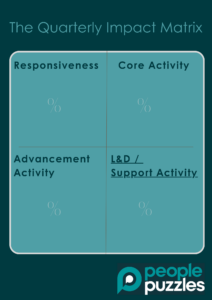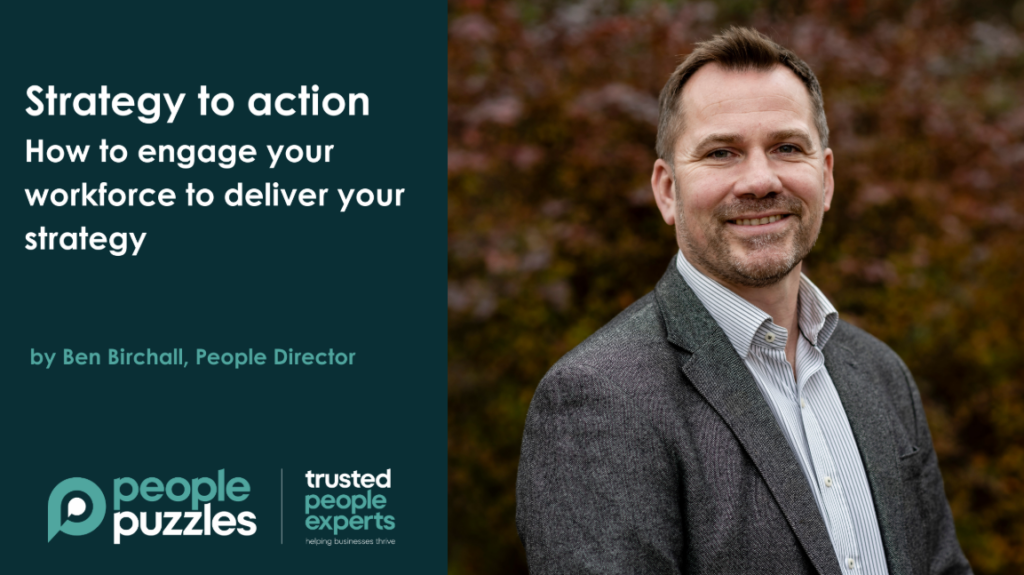Ben Birchall explains how to use his quarterly impact matrix, a practical, easy-to-use tool designed to help businesses cut down on wasted time, improve focus, and give employees clarity on their priorities.
As a business leader, you’re no stranger to the constant balancing act of keeping your team focused, productive, and aligned with the company’s goals. People Director Ben Birchall, who has worked closely with numerous businesses facing similar challenges, developed the quarterly impact matrix tool that’s been a game-changer for many.
The problem: lack of focus leading to poor productivity
Parkinson’s Law states: “Work expands to fill the time available for its completion”
From his experience, Ben identified that this is one of the key inhibitors to productivity throughout organisations.
We’ve all seen it: employees spending too much time on tasks that don’t move the business forward, getting bogged down in busy work, or simply reacting to whatever lands in their inbox. The lack of clear priorities often leads to inefficiency and frustration. Ben noticed that in many businesses, people weren’t clear on what they were supposed to achieve, or they were too caught up in day-to-day firefighting to focus on more meaningful work. In Ben’s words, he built this tool to help people have the laser focus of Usain Bolt!
Ben was inspired to create this tool after going into businesses and noticing a disconnect between strategy and action. He saw leaders spending a lot of time defining what needed to happen to make their business a success and then not effectively communicating that to their people. It led to employees not delivering the results that the employer wanted, but when Ben dug deeper, he discovered that often expectations had not been laid out and people were left to drift.
The solution: the quarterly impact matrix
A 2022 report by McKinsey showed that organisations using quarterly goal-setting frameworks saw a 30% improvement in task completion rates and alignment with business strategies. Ben recognised the importance of this when developing his model.
The quarterly impact matrix, goes one step further, not only setting quarterly goals but encouraging a more conscious approach to work allocation, prioritisation, time management and productivity. It breaks down work into four key areas that everyone can understand, giving them a clear way to talk about how they’re spending their time:
 Core activity
Core activity
This is your Business As Usual (BAU)—the tasks that are essential to keeping the business running. These are the must-do’s, aligned with your business goals. Think of it as the work people have to be good at to keep things ticking along. You can still have stretch targets within this quadrant, such as reducing errors or increasing sales.
Responsiveness
This covers the unpredictable tasks that come out of nowhere but must be handled. We all deal with these, whether it’s unexpected client requests, urgent internal issues, or sudden project changes. We often don’t block time out for this quadrant, meaning that we end up being distracted from BAU and the longer-term initiatives. The key here is understanding how much of your day is taken up by responding to these tasks and ensuring they don’t derail everything else by being more conscious of them.
Advancement Activity
This quadrant includes the strategic projects and initiatives that move your business forward. Ben’s experience is that, in most organisations, these get deprioritised because people are too busy with core activities or responsiveness, which leads to projects overrunning. But without focusing here, your business risks stagnation. Using this as a tool for consciousness, it encourages people to understand their capacity and allocate a realistic amount of time to deliver a goal.
Learning and Development / Support Activity (L&D)
This quadrant focuses on personal and professional growth. It’s easy to overlook training and development when everyone is focused on the day-to-day grind but investing in L&D is crucial for long-term success and employee satisfaction as well as to deliver activities in the other three quadrants.
Why it works and increases productivity
Ben says that these are the key benefits that clients report as a result of using the matrix:
It increases productivity
By breaking work into these four quadrants, it becomes clearer where time is being spent and cuts down on time-wasting. For example, if someone is spending too much time in the Responsiveness box, they may be reacting to every small issue instead of focusing on advancing bigger projects. Alternatively, their role may require them to be responsive, in which case allocating a greater percentage of their time to the responsive quadrant would benefit their time management. The matrix helps people realise when they need to shift their focus and rebalance their time.
It raises awareness and accountability
One of the most significant benefits of the quarterly impact matrix is the consciousness it creates around time management. It helps people reflect on how much of their day is being spent on low-impact tasks and encourages them to make more deliberate choices about their priorities. Employees and managers alike become more aware of where their efforts are going and where they should be going
It provides a common language
The matrix gives employees a clear, shared vocabulary to discuss their performance with their managers. Instead of vague or unproductive conversations about being “busy,” team members can use the matrix to show exactly where their time is going and where they might need help rebalancing it. It’s a tool that turns vague effort into measurable impact.
It drives motivation and engagement
When people understand how their role makes a difference and contributes to the overall business strategy, it is like having the key to unlock their potential to deliver your goals.
How to use it
Using the quarterly impact matrix isn’t complicated. It fits neatly into your regular quarterly review cycle, but rather than making that switch overnight, Ben suggests allowing a month’s transition period to reflect on the past quarter and plan for the next.
Set goals for each quadrant
During planning sessions, managers and employees should agree on targets for each of the four areas. What are the must-do’s for BAU? What new projects need advancing? What unexpected tasks might pop up? What skills or knowledge should the employee focus on developing?
Allocate a percentage of time to each quadrant
this way employees get a real sense of how much time they need to allocate to each quadrant. This can then be translated into hours or days, making it much more tangible and enabling planning. There is no ideal percentage split across the quadrants. Every department and employee will end up with an impact matrix with individual percentages in each quadrant and these can vary from one quarter to the next. Ben cites the example of a retail client whose revenue triples during Q4 as it is their busiest time. Using this tool, they can plan for the L&D and advancement activity quadrants to take a back seat.
Check in regularly
Use the matrix as a check-in tool during 1:1s. Have employees and managers review where time is going and adjust as needed. If someone is spending too much time being reactive, it’s time to reevaluate their priorities or adjust expectations.
End-of-quarter reflection
At the end of the quarter, review the matrix and see how things went. Identify what worked well – the enablers – and what could be improved – the constraints. This reflection period is key to learning and evolving as a business. It creates a culture where the business leaders are accountable for ensuring the enablers of performance and can adapt the conditions to get the best out of their teams.
Ben says that the beauty of this tool is that “Every quarter every employee has a personal plan for the next 90 days ahead that tells them what their focus is and how it relates to the overall business strategy.”
The results
The quarterly impact matrix has already made a noticeable impact for many of Ben’s clients. One client found that 25% of their workforce was being constrained by inefficient systems. By using the matrix, they were able to focus on what truly mattered and initiate changes to enable their people to maximise their impact. It also provided clarity for managers and employees alike, ensuring everyone knew exactly how their work was contributing to the company’s success.
One employee described the Quarterly Impact Cycle as the best process that had been introduced into the business in the past 10 years.
Another client shared that they had managed to deliver a new initiative which had been planned and overrunning for over 18 months. They said that this was due to a level of clarity and accountability that had not existed with previous strategy planning, execution and review processes.
A simple way to stay on track
The beauty of the quarterly impact matrix is in its simplicity. It helps your team stay focused, waste less time, and work more effectively. If you’re struggling with employees who seem overwhelmed or unsure about where to focus their efforts, this tool could be the solution you’re looking for.
By giving your team a clear structure for their work and an easy way to discuss their performance, the quarterly impact matrix helps you build a more productive, engaged, and focused workforce. And in the end, that’s what drives real business impact.



